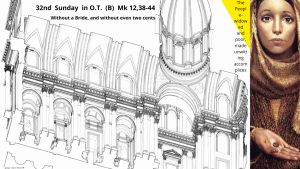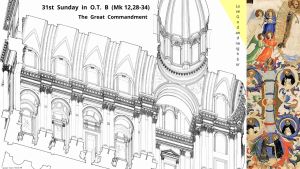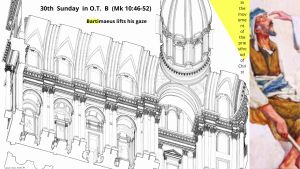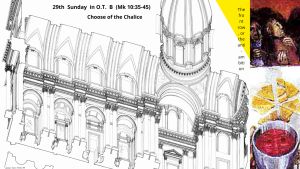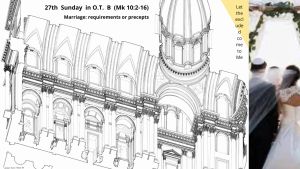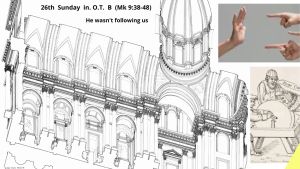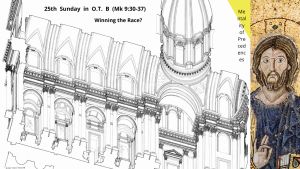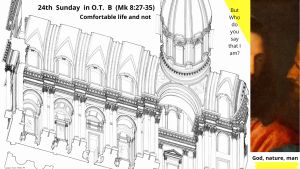
don Giuseppe Nespeca
Giuseppe Nespeca è architetto e sacerdote. Cultore della Sacra scrittura è autore della raccolta "Due Fuochi due Vie - Religione e Fede, Vangeli e Tao"; coautore del libro "Dialogo e Solstizio".
Widow-people: without a Bride, and without even two pennies
Listen Israel: Love God and Neighbor
BRIEF REFLECTION ON 'ENVY' (by Francesco Giovannozzi, psychologist and psychotherapist)
Some days I was in a bar. There were some young people talking about their daily problems, when at a certain point the issue of envy came up.
The discussion on this topic was also taken up by the people who were there and someone joking or not (who knows) expressed: but how do you remove it?
I was reminded of old magical and superstitious practices from when I was a child. Or of all those times I have heard people say in the face of a failure or unfavourable situation: 'I must go and have envy removed'. And not only from simple people, but also from people with a certain degree of culture. As already argued in previous articles, even the man of science has his irrational side.
In the Treccani dictionary under envy we read: 'An unpleasant feeling for a good or quality of others that one would like for oneself, often accompanied by aversion and resentment for the one who possesses it instead'.
It is a feeling we all have and which we refuse to acknowledge because it is often something we are ashamed of. We often believe that this feeling has occult powers and therefore believe that pseudo-magical practices can free us. Nothing could be more illusory.
Melanie Klein wrote the book 'Envy and Gratitude' where she addresses this issue.
This author investigated in depth the first relationship the child has with the mother's breast and then with the mother when it manages to perceive her as a total object. A primary relationship that can also be difficult due to maternal causes: non-acceptance of the baby, difficulties in childbirth, or reluctance to breastfeed.
But there are also causes that can arise from the baby, and among these is envy, which prevents a good relationship with the breast.
The baby may feel a great deal of anger towards the breast, whether it is perceived as good, i.e. that it satisfies him, or as bad - because it does not satisfy his needs and generates envy because it possesses something he does not have.
And so the infant tries to harm him as he can, by putting his naughty bits in (spitting, urinating, biting, etc.).
In a person a strong presence of envy can damage his way of life, and his relations with others; not because of external causes, but because he cannot understand the good object.
He feels that he has ruined it and made it bad.
He cannot feel its good feelings, and this increases his envy and hatred.
In contrast, the child who is more able to feel love and gratitude for the gift he has received, experiences the good object more.
Consequently, gaining confidence in his own goodness, he will overcome envy and hatred more easily.
The person suffering from envy can hardly enjoy the joys of life, because the relationship with the mother and then with any other object of love is damaged.
Positive feelings encourage the child to keep the milk received as good.
Experiencing gratitude is the basis of pleasure, and later he will be able to establish satisfying relationships, because destructive desires are diminished: his anxieties will be less.
Envy does not make us live well, for the simple reason that it goes against life - and the outside world becomes our enemy.
Or it makes us live a 'breast' that is too idealised or too bad.
A person with a good capacity to love can love the 'object' while seeing its limitations.
One positive thing that envy can operate in us is the possibility of improving ourselves.
Often, for those who seek help from a professional, among the various issues that the person brings to analysis, this problem must be addressed.
If the analyst is well aware of these destructive parts, he will be able to lead the person in front of him to recognise the negative parts, and to mitigate them with love and positive feelings.
The well-adjusted person will bear his or her own feelings of guilt better, and will not need to see them on others. .
Very often it is difficult to bear ourselves.
Francesco Giovannozzi Psychologist - Psychotherapist.
Barthymeus looks up from a middle life
Choice of the Chalice, or the front row
One you miss: leaving everything behind and experiencing the reversal
Marriage and repudiation: needs or precepts?
The guy is not following us? To be investigated!
Winning the Race
Raising the Cross, bad reputation
It has made us come here the veneration of martyrdom, on which, from the beginning, the kingdom of God is built, proclaimed and begun in human history by Jesus Christ (Pope John Paul II)
Ci ha fatto venire qui la venerazione verso il martirio, sul quale, sin dall’inizio, si costruisce il regno di Dio, proclamato ed iniziato nella storia umana da Gesù Cristo (Papa Giovanni Paolo II)
The evangelization of the world involves the profound transformation of the human person (Pope John Paul II)
L'opera evangelizzatrice del mondo comporta la profonda trasformazione delle persone (Papa Giovanni Paolo II)
The Church, which is ceaselessly born from the Eucharist, from Jesus' gift of self, is the continuation of this gift, this superabundance which is expressed in poverty, in the all that is offered in the fragment (Pope Benedict)
La Chiesa, che incessantemente nasce dall’Eucaristia, dall’autodonazione di Gesù, è la continuazione di questo dono, di questa sovrabbondanza che si esprime nella povertà, del tutto che si offre nel frammento (Papa Benedetto)
He is alive and wants us to be alive; he is our hope (Pope Francis)
È vivo e ci vuole vivi. Cristo è la nostra speranza (Papa Francesco
The Sadducees, addressing Jesus for a purely theoretical "case", at the same time attack the Pharisees' primitive conception of life after the resurrection of the bodies; they in fact insinuate that faith in the resurrection of the bodies leads to admitting polyandry, contrary to the law of God (Pope John Paul II)
I Sadducei, rivolgendosi a Gesù per un "caso" puramente teorico, attaccano al tempo stesso la primitiva concezione dei Farisei sulla vita dopo la risurrezione dei corpi; insinuano infatti che la fede nella risurrezione dei corpi conduce ad ammettere la poliandria, contrastante con la legge di Dio (Papa Giovanni Paolo II)
Are we disposed to let ourselves be ceaselessly purified by the Lord, letting Him expel from us and the Church all that is contrary to Him? (Pope Benedict)
Siamo disposti a lasciarci sempre di nuovo purificare dal Signore, permettendoGli di cacciare da noi e dalla Chiesa tutto ciò che Gli è contrario? (Papa Benedetto)
Jesus makes memory and remembers the whole history of the people, of his people. And he recalls the rejection of his people to the love of the Father (Pope Francis)
Gesù fa memoria e ricorda tutta la storia del popolo, del suo popolo. E ricorda il rifiuto del suo popolo all’amore del Padre (Papa Francesco)
Ecclesial life is made up of exclusive inclinations, and of tasks that may seem exceptional - or less relevant. What matters is not to be embittered by the titles of others, therefore not to play to the downside, nor to fear the more of the Love that risks (for afraid of making mistakes)
La vita ecclesiale è fatta di inclinazioni esclusive, e di incarichi che possono sembrare eccezionali - o meno rilevanti. Ciò che conta è non amareggiarsi dei titoli altrui, quindi non giocare al ribasso, né temere il di più dell’Amore che rischia (per paura di sbagliare).
Zacchaeus wishes to see Jesus, that is, understand if God is sensitive to his anxieties - but because of shame he hides (in the dense foliage). He wants to see, without being seen by those who judge him. Instead the Lord looks at him from below upwards; Not vice versa
Zaccheo desidera vedere Gesù, ossia capire se Dio è sensibile alle sue ansie - ma per vergogna si nasconde nel fitto fogliame. Vuole vedere, senza essere visto da chi lo giudica. Invece il Signore lo guarda dal basso in alto; non viceversa
duevie.art
don Giuseppe Nespeca
Tel. 333-1329741
Disclaimer
Questo blog non rappresenta una testata giornalistica in quanto viene aggiornato senza alcuna periodicità. Non può pertanto considerarsi un prodotto editoriale ai sensi della legge N°62 del 07/03/2001.
Le immagini sono tratte da internet, ma se il loro uso violasse diritti d'autore, lo si comunichi all'autore del blog che provvederà alla loro pronta rimozione.
L'autore dichiara di non essere responsabile dei commenti lasciati nei post. Eventuali commenti dei lettori, lesivi dell'immagine o dell'onorabilità di persone terze, il cui contenuto fosse ritenuto non idoneo alla pubblicazione verranno insindacabilmente rimossi.


